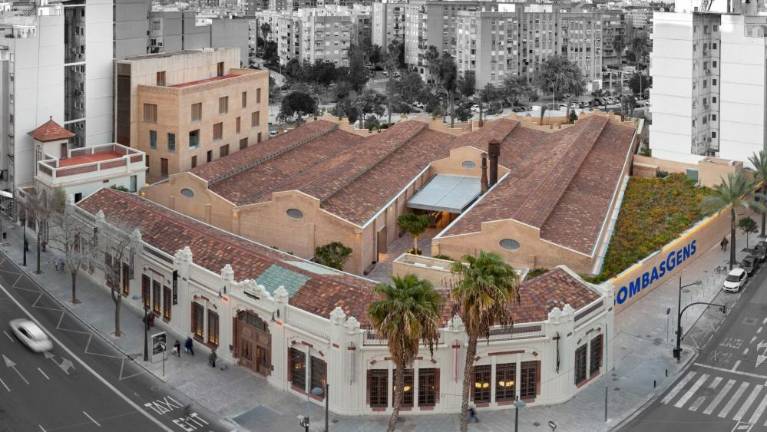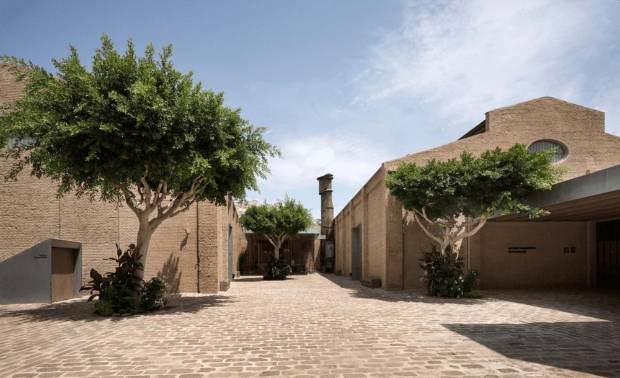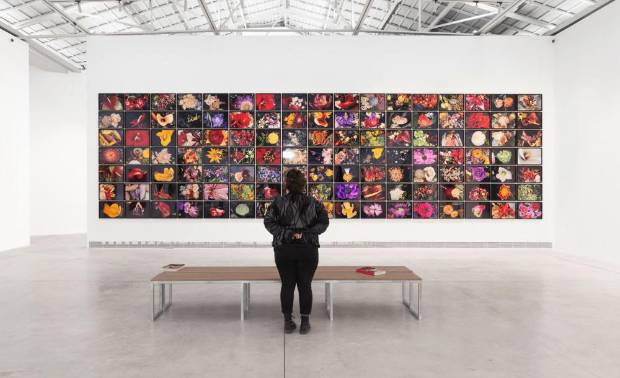Bombas Gens Centre d’art o cómo revalorizar una fábrica abandonada en València / World Design Spotlight: Bombas Gens Centre d’art
- Fotografías: Alfonso Calza y Bombas Gens Centre d’Art.

Rehabilitar una fábrica abandonada y convertirla en un referente del patrimonio industrial para un uso artístico y sociocultural. Eso es lo que hizo la Fundació Per Amor a l’Art con unas impresionantes naves de 1930 cerradas desde hacía décadas: transformarlas en Bombas Gens Centre d’Art.
Ser un espacio inclusivo dedicado a la cultura es lo que ha puesto, a este edificio de Valencia, en el mapa de los lugares más envidiados internacionalmente.
La apuesta de sus promotores cuando lo inauguraron en 2017 era bien clara: fundar un centro de arte abierto a todos, con entrada gratuita y sin subvenciones públicas; con un comedor para niños en riesgo de exclusión social y con un centro para coordinar la investigación sobre la enfermedad de Wilson, dolencia con la que los impulsores son, por motivos familiares, especialmente sensibles.
Un total de 6.000 metros cuadrados (2.600 de ellos, solo para exposiciones) repartidos entre cultura, solidaridad y ciencia, movidos por la profunda pasión de sus propietarios hacia el arte y por el convencimiento de que este nos mejora como sociedad.
Las obras que se exponen proceden de la Fundació Per Amor a l’Art, con los propios empresarios Susana Lloret y José Luis Soler al frente, entidad que soporta económicamente toda la inversión realizada en Bombas Gens. Solo para recuperar el edificio destinaron más de nueve millones de euros.
La historia
La historia del edificio se remonta a 1930, cuando el arquitecto Cayetano Borso di Carminati lo proyecta para un empresario, Carlos Gens, con la finalidad de ser la nueva sede de su consolidada fábrica de bombas hidráulicas, dando un salto a la modernidad desde los emplazamientos anteriores de la empresa.
El espacio, de un indudable valor histórico, es uno de los pocos ejemplos de arquitectura industrial que quedan en pie. Su edificio y el estilo art-decó de sus fachadas hacen de este lugar un enclave único para albergar estos nuevos usos que responden a las necesidades actuales.
El edificio padeció, también, las durezas de la Guerra Civil pues fue incautado por los republicanos para fabricar bombas, con lo que supuso un objetivo claro para el ataque del bando franquista. De ahí la existencia de un refugio antiaéreo, conservado todo este tiempo y que también se puede visitar. El inmueble en general se encontraba muy deteriorado después de muchos años de abandono, incendio incluido, tras cerrar sus puertas definitivamente en 1991.
El edificio padeció las durezas de la Guerra Civil pues fue incautado por los republicanos para fabricar bombas, con lo que supuso un objetivo claro para el ataque del bando franquista. De ahí la existencia de un refugio antiaéreo, conservado todo este tiempo y que también se puede visitar.
La intervención
Tres fueron los profesionales que dirigieron las intervenciones arquitectónicas en el complejo fabril para su recuperación en lo que es hoy: tras la consolidación de las naves, ejecutada por Eduardo de Miguel, Ramón Esteve asumió el desarrollo y la ampliación del proyecto y la arquitecta Annabelle Selldorf se ocupó de la parte museística.
A través de la fachada se accede al centro de arte, de forma directa; el restaurante queda a la derecha (dirigido por el cocinero Ricard Camarena, con estrella Michelin) y las oficinas, a la izquierda, con una presentación más discreta respecto a la entrada.

El proyecto de rehabilitación de Bombas Gens también contó con el diseño, por parte de Esteve, del patio trasero; un espacio que contiene el jardín realizado por el paisajista Gustavo Marina y la escultura site-specific de Cristina Iglesias.
En el patio se encuentra la bodega del siglo XV, cubierta, y el refugio antiaéreo de la Guerra Civil. Todos estos espacios están articulados con zonas verdes para permitir al visitante disfrutar adecuadamente de la escala del conjunto y descubrir cada uno de sus rincones.
El arquitecto Ramón Esteve explica cuál supuso el reto de la intervención, “lo más complicado fue la tarea de diseñar un espacio que representase a una fundación con una fuerte identidad, como es la Fundació per Amor a l’Art, y tratar de convertir esos valores en piedra, generando a su vez un escenario que sirviera para desarrollar diariamente sus funciones, actividades y objetivos”.
Por su parte, la arquitecta Annabelle Selldorf, responsable del proyecto museístico, apunta que los promotores del espacio, muy conscientes de la consideración que requería el espacio, “no estaban buscando a un diseñador que simplemente le diera al edificio una sensación radiante y novedosa, sino a alguien que abrazara el carácter histórico y le diera un nuevo propósito y una nueva fuerza. Vieron que el valor del arte y de la arquitectura podían contribuir a crear una sensación real de lugar que supusiera una verdadera aportación al barrio de Marxalenes, así como a València y a España”, explicaba en la publicación que editó la institución para conmemorar su primer aniversario.
“Cuando se me presenta la oportunidad de adaptar los edificios industriales o históricos a un nuevo uso mi enfoque es comprender a fondo las cualidades esenciales y la singularidad del edificio. A partir de este entendimiento y en el contexto de un nuevo propósito, se puede determinar qué aspectos restaurar, reparar o renovar y dónde se necesita una intervención”, señalaba la arquitecta.
“Creo que la arquitectura cobra vida, y se completa, por parte de quienes la usan y, con Bombas Gens, ha sido muy gratificante ver el centro lleno de gente disfrutando del arte y de los maravillosos programas presentados. Ha servido como un catalizador para la revitalización y el compromiso de la manera que esperábamos durante la planificación, pero que ha superado nuestras expectativas”, apuntaba Selldorf.
La colección
El centro de arte Bombas Gens cuenta, además, con un asesor de lujo en lo referente a la adquisición de obras: Vicent Todolí, ex-director de la Tate Modern, quien ha ido aconsejando, desde hace años, a Lloret y Soler hasta conformar una espléndida colección en la que destacan desde las obras de fotógrafos del siglo XX ya clásicos, como Walker Evans y Garry Winogrand, hasta las de fotógrafos recientes, pasando por piezas de los pintores Anna-Eva Bergman, Esteban Vicente y Juan Uslé o los escultores Juan Muñoz y Cristina Iglesias.

La colección artística tiene algunas pautas muy especiales y que merece la pena conocer: es de acceso público, sus obras no salen al mercado, no especulan con ellas y no pagan precios desmesurados.
El centro de arte aspira a atraer todo tipo de público, según ha explicado muchas veces Susana Lloret, cara visible de esta institución, “el objetivo es que la igualdad de oportunidades sea un poco más real”.
El diseño gráfico
El Estudio Gallén+Ibáñez, fundado por Carmina Ibáñez y Marisa Gallén, esta última galardonada con el Premio Nacional de Diseño 2019, firma la identidad gráfica de Bombas Gens.
El trabajo, cuyo logo parte de un motivo ornamental art déco extraído de la reja del edificio que representa una fuente, cumple con tres premisas necesarias: ser contemporáneo, ser reconocible y ser formalmente sintético. Este diseño ha sido reconocido con varios premios especializados: Laus, Clap, German Design Awards y La Lluna.
Las cifras
En definitiva, es un proyecto muy ambicioso, que ha dado vida a un edificio abandonado y con una proyección internacional que ha recibido el apoyo del público de una manera indudable.
Las cifras son rotundas: desde su apertura, en Bombas Gens ha habido 19 exposiciones y casi treinta mil asistentes a las 473 actividades que se han realizado en torno a las muestras (talleres, visitas guiadas), que han contado con una alta participación social.
Desde que abriera sus puertas, casi 200.000 personas han pasado por lo que, apenas unos años antes, era una imponente fábrica abandonada.
Como dice el arquitecto Rafael Moneo, “la vida de un edificio es una carrera completa a través del tiempo”. Bombas Gens es hoy un lugar con un diseño y una intención que hace, de Valencia, una ciudad mejor.
To renovate an abandoned factory and convert it into an expression of industrial heritage for artistic, social and cultural use. That is what the Fundació Per Amor a l’Art did with some impressive 1930 factory buildings that had been closed for decades: transform them into Bombas Gens Art Centre.
As an inclusive space dedicated to culture, this building in Valencia has found its way onto the international map of most envied places.
The aim of its developers when they inaugurated it in 2017 was very clear: to establish an art centre that was open to everybody, with free entry and without public subsidies; with a dining room for children at risk of social exclusion and a centre for coordination of research into Wilson’s disease, a condition to which the promotors are, for family reasons, especially sensitive.
A total of 6000 square metres (2600 for exhibitions alone) distributed between culture, altruism and science, stirred by the deep passion of its owners for art and their conviction that art improves us as a society.
The works on show belong to the collection of the Fundació Per Amor a l’Art, the entity led by entrepreneurs Susana Lloret and José Luis Soler that provided all the financial backing for the investment made in Bombas Gens. More than nine million euros were allocated merely to renovating the building.
The history
The history of the building goes back to 1930, when the architect Cayetano Borso di Carminati designed it for a businessman, Carlos Gens, to house the new headquarters of his successful hydraulic pump factory, taking a leap towards modernity from the company’s previous premises.
The space, with undisputed historical value, is one of the few examples of industrial architecture still standing. The building and the art deco style of its façades make this place a unique enclave to host these new uses that respond to today’s needs.
The building also suffered from the hardships of the Civil War since it was confiscated by the republicans to manufacture bombs, owing to which it became a clear target for attack by Franco’s band. This is the reason for the presence of an air raid shelter, conserved during all this time, and which can also be visited. The building was in general greatly deteriorated after being abandoned for many years, even suffering a fire after closing its doors definitively in 1991.
The intervention
Three professionals led the architectural interventions in the factory complex for its recovery to what it is today: after the factory buildings had been consolidated by Eduardo de Miguel, Ramón Esteve assumed the development and expansion of the project and the architect Annabelle Selldorf took care of the museum aspect.
The façade offers direct access to the art centre. The restaurant (managed by Michelin star chef Ricard Camarena) is set to the right and the offices to the left, with a more discreet presentation compared to the entrance.
The project for the renovation of Bombas Gens also included the design, by Esteve, of the factory yard; a space that contains a garden planned by landscape gardener Gustavo Marina and the site-specific sculpture of Cristina Iglesias.
The yard is the setting for the fifteenth century wine cellar and the Civil War air raid shelter. All these spaces are linked by green areas that allow the visitor to appreciate the scale of the complex and discover each one of its corners.
The architect Ramón Esteve explains the challenge represented by the intervention. “The most complicated task was to design a space that represented a foundation with such a strong identity as that of the Fundació per Amor a l’Art, and to try to convert those values into stone, generating in turn a suitable setting for the day-to-day performance of its functions, activities and aims.”
For her part, the architect Annabelle Selldorf, responsible for the museum design, points out that the developers of the complex, well aware of the consideration required by the space, “were not seeking a designer who would simply give the building a radiant and innovative feeling, but somebody who would embrace the historic character and give it a new aim and a new strength. They could see how the value of art and architecture could contribute to creating a real sense of place that would enhance the Marxalenes neighbourhood, as well as Valencia and Spain,” she explained in the publication issued by the institution to commemorate its first anniversary.
“When I am presented with the opportunity to adapt industrial or historic buildings for a new use, my focus is to reach a deep understanding of the essential qualities and the singularity of the building. Based on this understanding and on the context of a new aim, it is possible to determine which aspects to restore, repair or renovate and where an intervention is necessary,” explained the architect.
“I believe that architecture is brought to life, and completed, by those who use it, and with Bombas Gens it has been very rewarding to see the centre full of people enjoying the art and the wonderful programmes presented. It has served as a catalyst for revitalisation and commitment just as we hoped for during the planning stage, but it has exceeded our expectations,” pointed out Selldorf.
The collection
The Bombas Gens art centre also has a deluxe advisor where the acquisition of works is concerned: Vicent Todolí, ex-director of the Tate Modern, who has advised Lloret and Soler over many years, leading to the formation of a splendid collection of pieces which includes now classic photographers of the twentieth century, such as Walker Evans and Garry Winogrand, as well as recent photographers, also taking in pieces by the painters Anna-Eva Bergman, Esteban Vicente and Juan Uslé and sculptors Juan Muñoz and Cristina Iglesias.
The artistic collection has some very special guidelines that are worth knowing: it is publicly accessible, its works are not on the market, they are not subject to speculation, and exorbitant prices are not paid.
The art centre aspires to attract a broad public, as Susana Lloret, the visible face of this institution, has explained many times: “the aim is for equality of opportunities to be a little more real.”
The graphic design
The studio Gallén+Ibáñez, founded by Carmina Ibáñez and Marisa Gallén, the latter a winner of a National Design Award in 2019, is behind the graphic identity of Bombas Gens.
The work, with a logo based on an ornamental art deco motif representing a fountain lifted from the grille of the building, meets three necessary requirements: to be contemporary, recognisable and formally synthetic. This design has been recognised with various specialist awards: Laus, Clap, German Design Awards and La Lluna.
The figures
In short, this is a very ambitious project which has given life to an abandoned building and with an international projection that has received the unequivocal support of the public.
The figures are clear: since it opened, Bombas Gens has hosted 19 exhibitions and welcomed almost thirty thousand attendees to the 473 activities that have been held in relationship with the collections (workshops, guided tours) which have benefitted from a high degree of social participation.
Since it opened its doors, almost two hundred thousand people have passed through what was, just a few years ago, an imposing abandoned factory.
As the architect Rafael Moneo says, “the life of a building is a complete race through time.” Bombas Gens today is a place with a design and an intention that make Valencia a better city.

![Noviembre/Diciembre Nº290 {name=Headline, data=Noviembre/Diciembre Nº290, type=text, options=[], Milenium={name=Milenium, data=idcon=90390819;order=1.0, type=text, options=[]}, iterContentTypeIn=TeaserHeadline, iterContentTypeOut=Headline}](http://www.elperiodicodelazulejo.es/binrepository/184x250/5c0/174d250/none/10926/UWDI/clipboard-1_90390820_20251205113939.jpg)